Hitachi VM-H57A User Manual
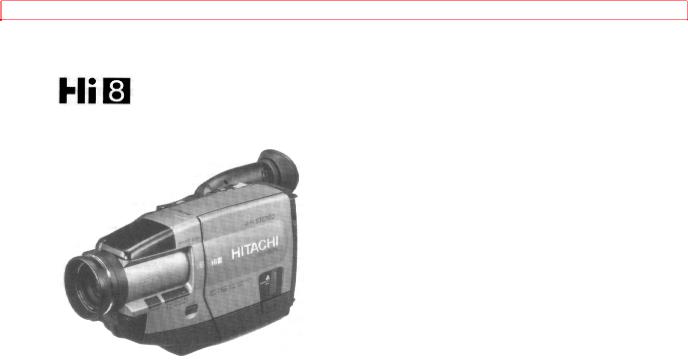
TABLE OF CONTENTS
HITACHI
Instruction Manual
8mm Video Camera/Recorder
VM-H57A
Hitachi Home Electronics (America), Inc. |
|
HITACHI (HSC) CANADA INC. |
3890 Steve Reynolds Blvd., Norcross, GA 30093 |
3300 Trans Canada Highway, |
|
Pointe Claire, |
|
|
Tel. 404-279-5600 |
Quebec, H9R 1B1, CANADA |
|
|
Tel. 514-697-9150 |
|
HITACHI SALES CORPORATION OF |
|
|
HAWAII, INC. |
|
|
3219 Koapaka Street, Honolulu, Hawaii 96819 |
|
|
Tel. 808-836-3621 |
|
|
|
|
E145554/E72118 |
P4708922 © Hitachi, Ltd. 1993 |
|
Printed in Japan KM-R(N) |

TABLE OF CONTENTS
TABLE OF CONTENTS
TABLE OF CONTENTS............................................................................................................................ |
2 |
For Your Safety........................................................................................................................................... |
4 |
Read This First ............................................................................................................................................ |
6 |
Before You Begin........................................................................................................................................ |
7 |
IMPORTANT SAFEGUARDS .................................................................................................................. |
7 |
IMPORTANT SAFETY INSTRUCTIONS FOR AC ADAPTER/CHARGER ...................................... |
12 |
Features............................................................................................................................................... |
13 |
Components and Accessories.......................................................................................................... |
14 |
Getting Started........................................................................................................................................... |
15 |
Charging the Battery .......................................................................................................................... |
15 |
Additional Information ........................................................................................................................ |
16 |
Adjusting the Electronic Viewfinder ................................................................................................. |
18 |
Eyepiece Adjustment ......................................................................................................................... |
18 |
Attaching the Shoulder Strap............................................................................................................ |
18 |
Attaching the Optional Wide or Tele Converter Lens ................................................................... |
20 |
Loading Batteries................................................................................................................................ |
20 |
Remote Control Battery..................................................................................................................... |
20 |
Camera/Recorder Battery ................................................................................................................. |
21 |
Removing the Battery ........................................................................................................................ |
21 |
Checking the Battery's Charge......................................................................................................... |
21 |
Using Alternative Power Sources .................................................................................................... |
23 |
Using the AC Adapter/Charger......................................................................................................... |
23 |
Using Alkaline Dry-Cell Batteries..................................................................................................... |
23 |
Using a Car Battery............................................................................................................................ |
24 |
Inserting and Removing Cassettes.................................................................................................. |
25 |
Inserting a Cassette ........................................................................................................................... |
25 |
Removing a Cassette......................................................................................................................... |
25 |
Protecting Recorded Material........................................................................................................... |
26 |
Attaching the Optional DC Camera Light ....................................................................................... |
26 |
Removing the DC Camera Light ...................................................................................................... |
27 |
Replacing the DC Camera Light Bulb ............................................................................................. |
27 |
Using Memory..................................................................................................................................... |
28 |
Setting the Date and Time ................................................................................................................ |
29 |
Correcting the Date and Time .......................................................................................................... |
30 |
Automatic Date Recording ................................................................................................................ |
30 |
Using the Linear Time Counter ........................................................................................................ |
30 |
Remaining Tape ................................................................................................................................. |
31 |
Using the Display Button................................................................................................................... |
31 |
Getting Started - Identifying Controls....................................................................................................... |
32 |
Basic Techniques....................................................................................................................................... |
36 |
Making a Basic Recording ................................................................................................................ |
36 |
Playing Back Your Recording........................................................................................................... |
37 |
Connecting to a Television with a VCR Attached.......................................................................... |
37 |
Connecting to a Television with Audio In and Video In Jacks..................................................... |
37 |

TABLE OF CONTENTS |
|
Connecting to a Television without Audio In and Video In Jacks ............................................... |
38 |
Simple Playback (Using the Electronic Viewfinder) ...................................................................... |
38 |
Using Still ............................................................................................................................................. |
38 |
Using Forward and Reverse Search ............................................................................................... |
39 |
Advanced Techniques ............................................................................................................................... |
39 |
Using the Power Zoom ...................................................................................................................... |
40 |
Using the Digital Zoom ...................................................................................................................... |
40 |
Using the INST. ZOOM (Instant Zoom) Button.............................................................................. |
41 |
Using Auto Focus ............................................................................................................................... |
42 |
Using Manual Focus .......................................................................................................................... |
43 |
Using the Electronic Image Stabilizer ............................................................................................. |
44 |
Using Fade .......................................................................................................................................... |
45 |
Fading In .............................................................................................................................................. |
45 |
Fading Out........................................................................................................................................... |
45 |
Using Instant Review ......................................................................................................................... |
46 |
Using Quick Edit ................................................................................................................................. |
46 |
Using Macro ........................................................................................................................................ |
46 |
Creating and Recording Titles.......................................................................................................... |
47 |
Creating a Title.................................................................................................................................... |
47 |
Correcting Errors ................................................................................................................................ |
48 |
Recording Title on a Tape in the Camera/Recorder..................................................................... |
48 |
Recording a Title while Transferring a Tape .................................................................................. |
49 |
Using the Wireless Remote Control ................................................................................................ |
50 |
Dubbing from the Camera/Recorder to a VCR.............................................................................. |
50 |
Using Synchro Edit............................................................................................................................. |
51 |
Controlling Your TV with the Camera/Recorder's Remote .......................................................... |
52 |
Programming the Remote Control................................................................................................... |
52 |
Controlling the TV............................................................................................................................... |
53 |
Using Audio/Video Dubbing.............................................................................................................. |
54 |
Recording Television Programs....................................................................................................... |
55 |
General Maintenance................................................................................................................................. |
55 |
Cleaning the Camera/Recorder Heads........................................................................................... |
55 |
Cleaning the Lens and Picture Tube of the Electronic Viewfinder ............................................. |
57 |
Periodic Maintenance ........................................................................................................................ |
57 |
Troubleshooting .................................................................................................................................. |
58 |
Specifications ............................................................................................................................................ |
61 |
Accessories Add Excitement..................................................................................................................... |
63 |
To Order in the United States........................................................................................................... |
63 |
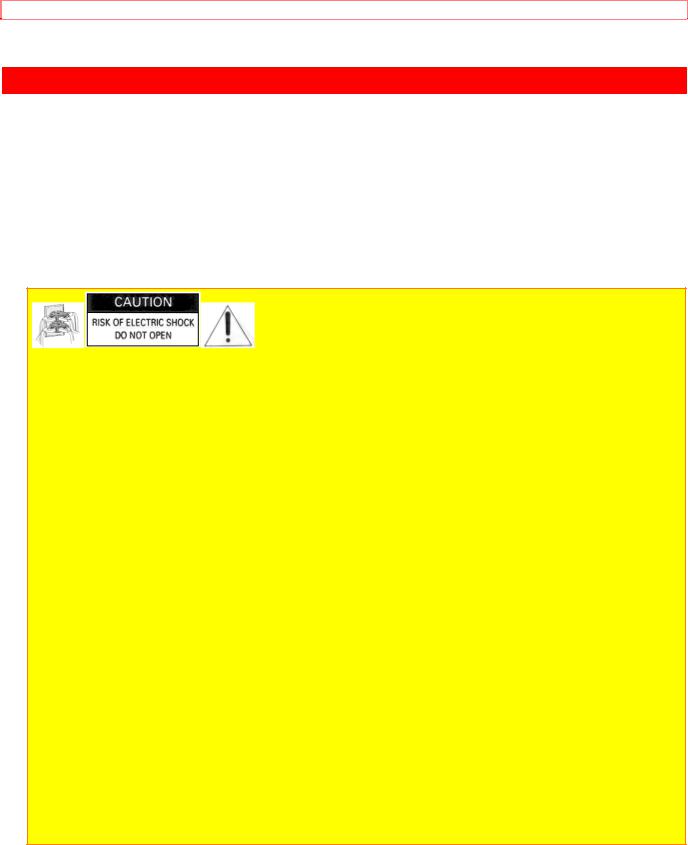
For Your Safety
For Your Safety
The CAMERA/OFF/VIDEO switch turns the camera/recorder on and off, leaving the date/time feature unaffected. If the unit is to be left unattended for a long period of time,
Tturn the camera/recorder off and attach the lens cap.
Illustrated below is the label on the bottom of your unit.
 This symbol warms the user that uninsulated voltage within the unit may have sufficient magnitude to cause electrical shock. Therefore, it is dangerous to make any kind of contact with any inside part of this unit.
This symbol warms the user that uninsulated voltage within the unit may have sufficient magnitude to cause electrical shock. Therefore, it is dangerous to make any kind of contact with any inside part of this unit.
 This symbol alerts the user that important literature concerning the operation and maintenance of this unit has been included. Therefore, it should be read carefully to avoid any problems.
This symbol alerts the user that important literature concerning the operation and maintenance of this unit has been included. Therefore, it should be read carefully to avoid any problems.
CAUTION: TO REDUCE THE RISK OF ELECTRIC SHOCK, DO NOT OPEN. NO USER-SERVICEABLE PARTS INSIDE.
REFER SERVICING TO QUALIFIED SERVICE PERSONNEL.
WARNING: Many television programs and films are copyrighted. In certain circumstances, copyright law may apply to private in-home videotaping of copyrighted materials.
WARNING: TO PREVENT FIRE OR ELECTRIC SHOCK, MATCH WIDE BLADE OF PLUG TO WIDE SLOT, AND FULLY INSERT PLUG.
This digital apparatus does not exceed the Class B limits for radio noise emissions from digital apparatus as set out in the Radio Interference regulations of the Canadian
Department of Communications.
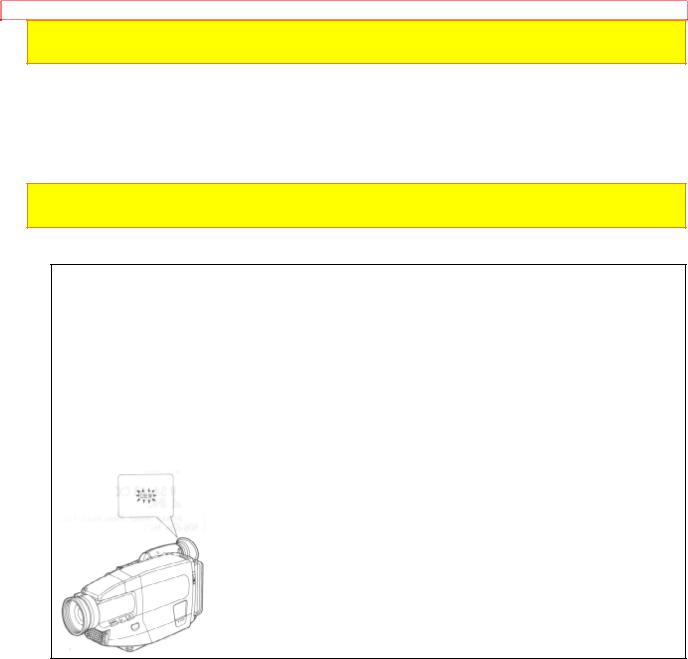
For Your Safety
Caution to the user: Changes or modifications not expressly approved by the party responsible for compliance could void the user's authority to operate the equipment.
This camera/recorder can use 8mm and  video cassettes. It automatically determines the loaded cassette is 8mm or and
video cassettes. It automatically determines the loaded cassette is 8mm or and  records and plays it back correctly.
records and plays it back correctly.
WARNING: TO PREVENT FIRE OR SHOCK HAZARD, DO NOT EXPOSE THIS UNIT TO RAIN OR MOISTURE.
MOISTURE
When the camera/recorder is exposed to rapid temperature changes from cold to warm, drops of moisture can form inside the mechanism. A flashing "DEW" indication in the viewfinder indicates that moisture has condensed on the recorder mechanism, which could result in tape damage. Since condensation builds up gradually, the indication does not appear immediately when condensation starts. When the temperature or humidity of the room changes abruptly, turn the power on and check that the "DEW" indication does not appear, then wait for about an hour for safety before using the camera/recorder. When the "DEW" indication in the viewfinder is flashing the unit will not operate. When this happens, slide the "EJECT" switch, remove the tape, and wait for the moisture to dry...the "DEW" indication in the viewfinder will stop flashing.

Read This First
Read This First
Thank you for buying a Hitachi product. You've chosen the best 8 mm video camera/recorder for you, and we want to help you make the most of your purchase.
Please take time to become familiar with the manual and how it is set up. Keep it handy for future reference.
To guide you, we've included:
•A "Before You Begin" section containing important cautions for your family's safety as well as instruction for getting your video camera/recorder ready for use. Please read and understand this section thoroughly before moving on.
•A "Getting Started" section to familiarize yourself with the controls and prepare you for recording.
•A "Basic Techniques" section to allow you to use your video camera/recorder quickly and confidently before advancing to the more sophisticated features of the Hitachi VMH57A.
•"Advanced Techniques" to help you with some of the exciting, sophisticated features of the Hitachi VM-H57A. We hope you will take the time to learn about these functions since they have been designed for you. You can use the video camera/recorder without reading this section.
•A "General Maintenance" section to help keep your purchase in good repair.
We want this manual to be as helpful as possible, so it includes two easy ways to find the information you need:
•A quick index for the information you use most often (this page).
•A detailed table of contents directing you to specific information quickly (page 8).
Get to know your video camera/recorder by using this manual, and get to know Hitachi. We appreciate your business.
Quick Index |
|
|
Charging the Battery..... |
10 |
|
Making a Basic Recording..... |
24 |
|
Playing Back Your Recording..... |
24 |
|
Using Power Zoom..... |
30 |
|
Using Digital Zoom..... |
30 |
|
Using the Wireless Remote Control.....37
Dubbing from Camera/Recorder to VCR.....38

Before You Begin
Before You Begin
Any problems that occur as a result of any of the following conditions will not be covered by our warranty.
Be careful that no water, dust or sand enters the camera/recorder.
When you shoot at a scene which contains an extremely bright object such as the sun or a light source, a bright vertical bar may appear in the picture.
Your camera/recorder is functioning properly, but the solid-state pickup device (CCD) usually causes this as an inherent characteristic. Try to avoid shooting an excessive bright object directly.
Be sure not to leave it in a place where the temperature exceeds 120° (49°C), or the pickup device may be damaged.
Dangerous includes:
•Inside a car with the windows closed and in direct sunshine.
•Near heating appliances.
Do not leave the viewfinder lens facing sunlight for a prolonged period, or the phosphorescent surface of the cathode ray tube may be damaged.
IMPORTANT SAFEGUARDS
In addition to the careful attention devoted to quality standards in the manufacture of your video product, safety is a major factor in the design of every instrument. But, safety is your responsibility too.
This page lists important information that will help to assure your enjoyment and proper use of a Video Camera/Recorder and accessory equipment. Please read it carefully before operating your video product and keep it in a handy place for future reference.
INSTALLATION
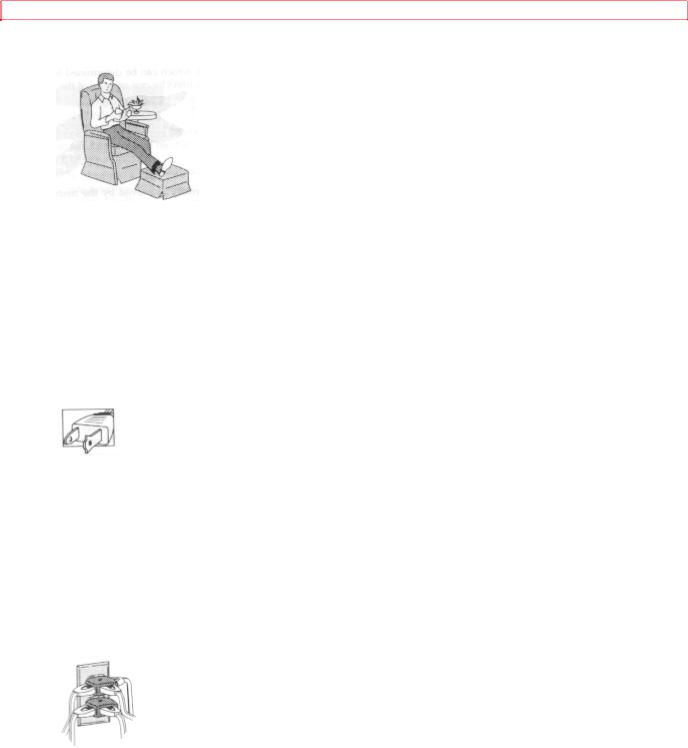
IMPORTANT SAFEGUARDS
1Read and Follow Instructions -- All the safety and operating instructions should be read before the video product is operated. Follow all operating and use instructions.
2Retain Instructions -- The safety and operating instructions should be retained for future reference.
3Heed Warnings -- Comply with all warnings on the video product and in the operating instructions.
4Polarized Plug -- This video product is equipped with a polarized alternating-current line plug (a plug having one blade wider than the other). This plug will fit into the power outlet only one way. This is a safety feature. If you are unable to insert the plug fully into the outlet, try reversing the plug. If the plug should still fail to fit, contact your electrician to replace your obsolete outlet. To prevent electric shock do not use this polarized plug with an extension cord, receptacle or other outlet unless the blades can be fully inserted without blade exposure. If you need an extension, use a polarized cord.
5Power Sources -- This video product should be operated only from the type of power source indicated on the marking label. If you are not sure of the type of power supply to your home, consult your video dealer or local power company. For video products intended to operate from battery power, or other sources, refer to the operating instructions.
6Overloading -- Do not overload wall outlets and extension cords as this can result in a risk of fire or electric shock. Overloaded AC outlets and extension cords are dangerous, and so are frayed power cords, damaged or cracked wire insulation and broken plugs. They may result in a shock or fire hazard. Periodically examine the cord and have it replaced by your service technician if appearance indicates damage or deteriorated insulation.
7Power-Cord Protection -- Power-supply cords should be routed so that they are not likely to be walked on or pinched by items placed upon or against them, paying particular attention to cords at plugs, convenience receptacles, and the point where they exit from the appliance.
8Ventilation -- Slots and openings in the cabinet are provided for ventilation to ensure reliable operation of the video product and to protect it from overheating. These openings must not be blocked or covered. The openings should never be blocked by placing the video product on a bed, sofa, rug or other similar surface. This video product should never be placed near or over a radiator or heat register. This video product should not be placed in a built-in installation such as a bookcase or rack unless proper ventilation is provided or the video product manufacturer's instructions have been

IMPORTANT SAFEGUARDS
followed.
9 Attachments -- Do not use attachments unless recommended by the video product manufacturer as they may cause hazards.

IMPORTANT SAFEGUARDS
Caution: Maintain electrical safety. Powerline operated equipment or accessories connected to this unit should bear the UL listing mark or CSA certification mark on the accessory itself and should not have been modified so as to defeat the safety features. This will help avoid any potential hazard from electric shock or fire. If in doubt, contact qualified service personnel.
10Water and Moisture -- Do not use this video product near water - for example, near a bath tub, wash bowl, kitchen sink, or laundry tub, in a wet basement, or near a swimming pool, and the like.
11Accessories -- Do not place this video product on an unstable card, stand, tripod, bracket, or table. The video product may fall, causing serious injury to a child or adult, and serious damage to the appliance. Use only with a cart, stand, tripod, bracket, or table recommended by the manufacturer, or sold with the video product. Any mounting of the product should follow the manufacturer's instructions, and should use a mounting accessory recommended by the manufacturer.
11A An appliance and cart combination should be moved with care. Quick stops, excessive force, and uneven surfaces may cause the appliance and cart combination to overturn.
12Outdoor Antenna Grounding -- If an outside antenna or cable system is connected to the video product, be sure the antenna or cable system is grounded so as to provide some protection against voltage surges and built-up static charges. Section
810of the National Electrical Code, ANSI/NFPA No. 70, provides information with respect to proper grounding of the mast and supporting structure, grounding of the leadin wire to an antenna discharge unit, size of grounding conductors, location of antennadischarge unit, connection to grounding electrodes, and requirements for the grounding electrode. See example below:
EXAMPLE OF ANTENNA GROUNDING
13Power Lines -- An outside antenna system should not be located in the vicinity of overhead power lines or other electric light or power circuits, or where it can fall into such power lines or circuits. When installing an outside antenna system, extreme care should be taken to keep from touching or approaching such power lines or circuits as contact with them might be fatal. Installing an outdoor antenna can be hazardous and should be left to a professional antenna installer.
USE
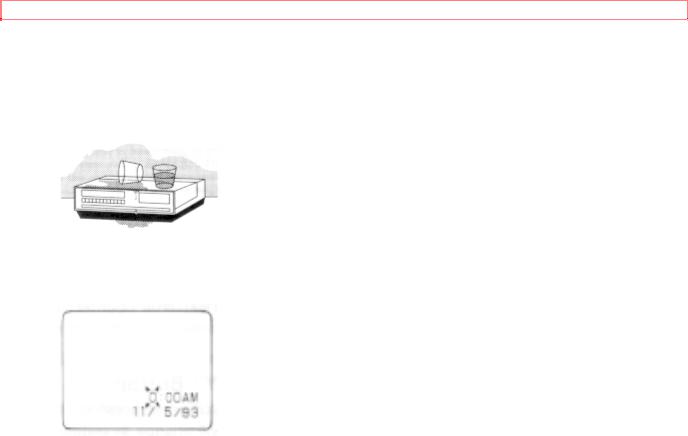
IMPORTANT SAFEGUARDS
14Cleaning -- Unplug this video product from the wall outlet before cleaning. Do not use liquid cleaners or aerosol cleaners. Use a damp cloth for cleaning.
15Object and Liquid Entry -- Never push objects of any kind into this video product through openings as they may touch dangerous voltage points or short-out parts that could result in a fire or electric shock. Never spill liquid of any kind on the video product.
16Lightning -- For added protection for this video product during a lightning storm, or when it its left unattended and unused for long periods of time, unplug it from the wall outlet and disconnect the antenna or cable-system. This will prevent damage to the video product due to lightning and power-line surges.
SERVICE
17Servicing -- Do not attempt to service this video product yourself as opening or removing covers may expose you to dangerous voltage or other hazards. Refer all servicing to qualified service personnel.
18Conditions Requiring Service -- Unplug this video product from the wall outlet and refer servicing to qualified service personnel under the following conditions.
a. When the power-supply cord or plug is damaged
b. If liquid has been spilled, or objects have fallen into the video product. c. If the video product has been exposed to rain or water.
d. If the video product does not operate normally by following the operating instructions.
Adjust only those controls that are covered by the operating instructions. Improper adjustment of other controls may result in damage and will often require extensive work by a qualified technician to restore the video product to its normal operation.
e. If the video product has been dropped or the cabinet has been damaged.
f. When the video product exhibits a distinct change in performance - this indicates a need for service.
19Replacement Parts -- When replacement parts are required, have the service technician verify that the replacements he uses have the same safety characteristics as the original parts. Use of replacements specified by the video product manufacturer can prevent fire, electric shock or other hazards.
20Safety Check -- Upon completion of any service or repairs to this video product, ask the service technician to perform safety checks recommended by the manufacturer to determine that the video product is in safe operating condition.

IMPORTANT SAFETY INSTRUCTIONS FOR AC ADAPTER/CHARGER
IMPORTANT SAFETY INSTRUCTIONS FOR AC ADAPTER/CHARGER
1.Save these instructions -- This page contains important safety and operating instructions for AC Adapter/Charger Model VM-AC82A(R).
2.Before using AC Adapter/Charger, read all instructions and cautionary markings on
(1) AC Adapter/Charger, (2) battery and (3) product using battery.
3.Also read all instructions on pages 4 and 5.
4.Caution -- To reduce risk of injury, charge only rechargeable battery, VM-BP82(G), VMBP82 or VM-BP83.
Other types of batteries may burst causing personal injury and damage.
5.Do not expose charger to rain or snow.
6.Use of an attachment nor recommended or sold by the battery charger manufacturer may result in a risk of fire, electric shock, or injury to persons.
7.To reduce risk of damage to electric plug and cord, pull by plug rather than cord when disconnecting charger.
8.Make sure cord is located so that it will not be stepped on, tripped over, or otherwise subjected to damage or stress.
9.Do not operate charger with damaged cord or plug - replace them immediately.
10.An extension cord should not be used unless absolutely necessary.
Use of improper extension cord could result in a risk of fire and electric shock. If extension cord must be used, make sure:
A.The pins on plug of extension cord are the same number, size, and shape as those of plug on charger.
B.That extension cord is properly wired and in good electrical condition; and
C.That wire size should be met below:
Minimum |
|
AWG size |
Length of extension cord (feet) |
18 |
Equal to or less than 100 |
16 |
Equal to or less than 150 |
11.Do not operate charger if it has received a sharp blow, been dropped, or otherwise damaged in any way; take it to a qualified serviceman.
12.Do not disassemble charger: take it to a qualified serviceman when service or repair is required. Incorrect reassembly may result in a risk of electric shock or fire.
13.To reduce risk of electric shock, unplug charger from outlet before attempting any maintenance or cleaning.
"Note to CATV system installer: This reminder is provided to call the CATV system installer's attention to Article 820-40 of the NEC that provides guidelines for proper grounding and, in particular, specifies that the cable ground shall be connected to the grounding system of the building, as close to the point of cable entry as practical".

IMPORTANT SAFETY INSTRUCTIONS FOR AC ADAPTER/CHARGER
NOTES:
•This unit uses  video format cassettes.
video format cassettes.
•It records and plays back in the SP mode (14.3 mm/sec.).
•It cannot record and play back in the LP mode (7.2 mm/sec.).
•This camera/recorder uses a Hi-Fi stereo sound system. When a tape recorded by this camera/recorder is played by a conventional 8mm camera/recorder, monaural sound is output. When a tape recorded by a conventional 8mm camera/recorder is played by this machine, monaural sound is output.
Features
•
•Easy to use
•16x zoom ratio
•Instant zoom
•Multi-function TV/Cam remote control
•Image stabilization

IMPORTANT SAFETY INSTRUCTIONS FOR AC ADAPTER/CHARGER
Components and Accessories
Check that you have the following components and accessories before preceding.
1.AV stereo output cord with S-VIDEO plug
2.Battery pack
3.AC adapter/charger
4.Remote control battery
5.Shoulder Strap
6.External power adapter
7.Remote control

Getting Started
Getting Started
This section guides you through the initial preparation of the camera/recorder. None of these processes are complex. Set aside some time, relax, and familiarize yourself with this quality instrument.
Enjoy getting to know all about your Hitachi 8mm camera/recorder. The more comfortable and familiar you are with the machine and its features, the more you can make it do for you. Let's get started!
It is crucial that you read and understand all the safety instructions before you begin. If you haven't read the safety instructions yet, please take the time to do so now.
Charging the Battery
The first step is to set the battery to charge. It takes approximately an hour, enough time to familiarize yourself with some of the basic features of the camera/recorder. Once charged the battery will give you approximately 55 ~ 65 minutes of operating time depending on the use of ZOOM and Start/Stop.
Charge the battery at a temperature range of 50°F(10°C) - 86°F (30°C) to prevent damage to the battery.
1.Plug the AC adapter/charger power cord into an AC outlet. Make sure that the wide blade fits into the wide slot. If it doesn't fit try reversing it. If you still cannot make fit the blades fully into the outlet either contact an electrician to replace your obsolete outlet, or use a polarized cord or outlet accessory.
2.To insert the battery into the charger align the reference arrow on the battery with the reference arrow on the AC adapter/charger. Push the battery till it is flush with the AC adapter/charger sliding it in the direction of the arrow as shown in the figure.
3.The CHARGE light remains on while the battery charges, turning off when charging completes.
Note: Remove the external power adapter from the AC adapter/charger before attempting to charge the battery. The CHARGE light flashes if the external power adapter remains connected while you attempt to charge the battery.
Note: Do not operate the battery at temperature below 14°F (-10°C) or above 95°F (35°C).
At extremely low temperatures operation time decreases, while at high temperature the battery may be damaged.
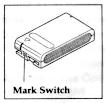 After charging set the mark switch to red so that you may quickly identify
After charging set the mark switch to red so that you may quickly identify

Getting Started
whether the battery is charged or uncharged.
Note: The marker switch is not concerned with the battery's performance.
Additional Information
To use a battery in optimum condition:
•Use the battery until the low charge light ( ) flashes. Using a battery for a short time and then recharging it may shorten the operation time.
) flashes. Using a battery for a short time and then recharging it may shorten the operation time.
•It is recommended to refresh an battery before recharging it when it has not been used for long time; otherwise its operation time becomes short. Press the refresh button.
After refreshing is complete, the REFRESH light turns off and the CHARGE light turns on and charging begins automatically.
Refreshing a fully charged battery takes approximately 4 hours, adding considerable time to battery charging.
With repeated normal charging and use the battery will gradually lose operating time. When operation time becomes too short to be useful, replace the battery.
If the POWER light begins to flash during charging, remove the battery and then reattach it to the AC charger/adapter. If the POWER light continues to flash after several attempts to attach it, the battery is unable to take a charge and must be replaced.
Do not attach a hot battery to the AC adapter/charger. Allow it to cool. Attaching a hot battery to the AC adapter/charger causes the POWER light to flash.
THERE ARE NO USER-SERVICEABLE PARTS INSIDE THE BATTERY OR AC
ADAPTER/CHARGER.
THROWING THE BATTERY INTO FIRE OR EXPOSING IT TO EXCESSIVE HEAT
(ABOVE 149°F (65°C)) MAY CAUSE INJURY.
SHORTING THE BATTERY'S TERMINAL INCREASES RISK OF FIRE OR
ELECTRICAL SHOCK.

Getting Started
ATTENTION:
The product that you have purchased contains a rechargeable battery. The battery is recyclable. At the end of its useful life, under various state and local laws, it may be illegal to dispose of this battery into the municipal waste stream. Check with your local solid waste officials for details in your area for recycling options or proper disposal.

Getting Started
Adjusting the Electronic Viewfinder
The electronic viewfinder adjusts simply by pivoting it to a position where it is comfortable and easy to see through. Place the viewfinder back in its original position before storing the camera/recorder in its case or carrying the camera recorder around to avoid damaging the viewfinder or camera/recorder.
Eyepiece Adjustment
To use the electronic viewfinder, pull out the eye cup all the way when using it and adjust the diopter control so that the subject is seen most clearly in the viewfinder. Always push in the eye cup after use.
Attaching the Shoulder Strap
Thread the ends of the provided shoulder strap through the slots at the back of the camera/recorder and thread through the shoulder straps' buckles. Please ensure that the straps are securely fastened before using the shoulder strap to carry the camera/recorder.

Getting Started
